
Wonder Boy in Monster Land, known by its original arcade release as Wonder Boy: Monster Land, is a platform video game developed by Westone Bit Entertainment and released by Sega in Japanese arcades in 1987 and for the Master System in 1988, with a number of other home computer and console ports following. The game is the sequel to the 1986 game Wonder Boy and takes place eleven years after the events in the previous game. After enjoying over a decade of peace on Wonder Land following the defeat of the evil King by Tom-Tom, later bestowed the title "Wonder Boy", a fire-breathing dragon called the MEKA dragon appeared; he and his minions conquered Wonder Land, turning it into "Monster Land". The people, helpless due to their lack of fighting skill, call for Wonder Boy, now a teenager, to destroy the monsters and defeat the MEKA dragon. Players control Wonder Boy through twelve linear levels as he makes his way through Monster Land to find and defeat the MEKA dragon. Players earn gold by defeating enemies and buy weapons, armor, footwear, magic, and other items to help along the way.

Curse of the Azure Bonds is a role-playing video game developed and published by Strategic Simulations, Inc (SSI) in 1989. It is the second in a four-part series of Forgotten Realms Advanced Dungeons & Dragons Gold Box adventure computer games, continuing the events after the first part, Pool of Radiance.
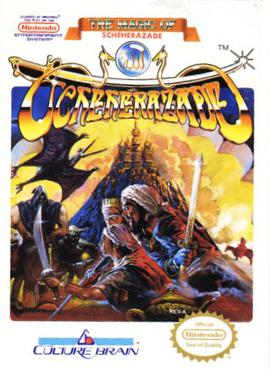
The Magic of Scheherazade is an action-adventure/role-playing video game (RPG) developed and released by Culture Brain for the Nintendo Entertainment System (NES). The game was released in 1987 in Japan and 1990 in North America. The plot is based on Middle Eastern folktales found in One Thousand and One Nights. It involves an amnesic hero traveling through time in an attempt to rescue the princess Scheherazade from the evil wizard Sabaron, who has summoned a horde of demons to bring chaos to the once peaceful land of Arabia. The Magic of Scheherazade is divided into chapters and incorporates elements of both action-adventure and RPG gameplay styles. In each chapter, the player character can freely explore an overworld in a top-down perspective. The player engages hostile enemies with various weapons and spells through both real-time solo action on the overhead map and random, turn-based battles fought alongside befriended allies.

Ultima VI: The False Prophet, released by Origin Systems in 1990, is the sixth part in the role-playing video game series of Ultima. It is the third and final game in the "Age of Enlightenment" trilogy. Ultima VI sees the player return to Britannia, at war with a race of gargoyles from another land, struggling to stop a prophecy from ending their race. The player must help defend Britannia against these gargoyles, and ultimately discover the secrets about both lands and its peoples.

Conquests of Camelot: The Search for the Grail is a graphic adventure game released in 1990 by Sierra On-Line. It was the first game in the Conquests series designed by Christy Marx and her husband Peter Ledger. The only other game in the series was 1991's Conquests of the Longbow: The Legend of Robin Hood. Marx did the majority of the design work while Ledger created the game and package art.

Xenon 2: Megablast is a 1989 shoot 'em up video game developed by The Bitmap Brothers and published by Image Works for the Amiga and Atari ST. It was later converted to the Master System, PC-98, X68000, Mega Drive, Commodore CDTV, Game Boy, Acorn Archimedes and Atari Jaguar platforms. The game is a sequel to Xenon and takes place a millennium after the previous title. The goal of the game is to destroy a series of bombs planted throughout history by the Xenites, the vengeful antagonists of the first game.
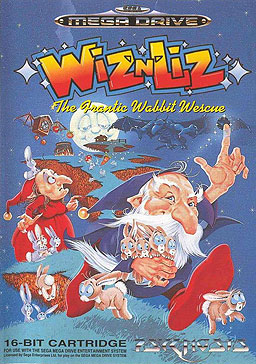
Wiz 'n' Liz: The Frantic Wabbit Wescue is a platform game developed by Raising Hell Software for the Amiga and Sega Mega Drive and published by Psygnosis in 1993. It is a humorous, cutesy platform game. With the exception of some end-of-level bosses, the game contains no enemies.

Obitus is an action-adventure game developed and released by Psygnosis in early 1991 for Amiga, Atari ST and DOS. It was also ported to the Super Nintendo Entertainment System by Bullet-Proof Software. The game features both first-person dungeon crawling and side-scrolling gameplay with action-oriented combat and an emphasis on item acquisition. It is similar to games like Eye of the Beholder on Super Nintendo but without the RPG mechanics.

There have been several video games based on the 1991 film Hook. A side-scrolling platform game for the Nintendo Entertainment System (NES) and Game Boy was released in the United States in February 1992. Subsequent side-scrolling platform games were released for the Commodore 64 and the Super Nintendo Entertainment System (SNES), and an arcade beat ‘em up by Irem later in 1992, followed by versions for the Sega CD, Sega Genesis, and Sega's handheld Game Gear console in 1993.
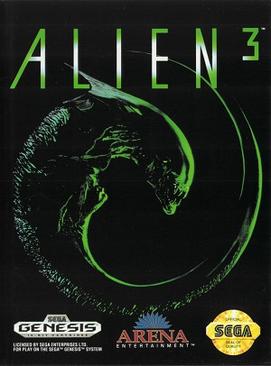
Alien 3 is a run and gun game based on the 1992 film of the same name. It was released for the Genesis and Amiga in 1992, then for the Commodore 64, Game Boy, Game Gear, Nintendo Entertainment System, Super Nintendo Entertainment System, and Master System.

The Adventures of Robin Hood is a video game released in the autumn of 1991 by Millennium Interactive.

Ambermoon is a role-playing game developed and published by Thalion Software, released in 1993 for the Amiga. It was the second part of an unfinished trilogy.

Elvira II: The Jaws of Cerberus is the second game in the Elvira series of horror adventure/role-playing video games. It was developed by Horror Soft and published by Accolade in 1992. The game is a sequel to 1990's Elvira: Mistress of the Dark. It was followed by Waxworks, which can be considered its spiritual sequel.
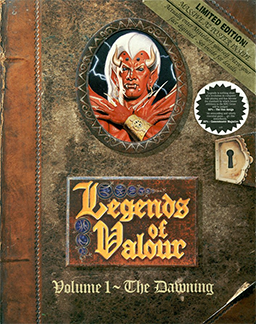
Legends of Valour is a role-playing video game developed by Synthetic Dimensions and released by U.S. Gold and Strategic Simulations in 1992 for the Amiga, Atari ST and MS-DOS, with the additional FM Towns and PC-98 versions in 1993-1994 in Japan only. As the game was planned to be a first part of the series, its full title is Legends of Valour: Volume I – The Dawning. The proposed unreleased sequel to Legends of Valour was to take place in the world outside Mitteldorf, the enclosed city where the entirety of Legends of Valour takes place.

MegaTraveller 1: The Zhodani Conspiracy is a 1990 space science fiction role-playing video game based on the Traveller series and was produced by Game Designers' Workshop licensee Paragon Software for Amiga, Atari ST, and MS-DOS. The game is set within the Official Traveller Universe and features character creation and other aspects of game mechanics compatible with prior Traveller products. The player controls up to five ex-military adventurers whose objective is to save their civilization, the Imperium, from a conspiracy instigated by the Zhodani, a rival spacefaring race, and aided by the actions of a traitor named Konrad Kiefer. Gameplay features real-time planetary and space exploration, combat, trading, and interaction with various non-player characters in eight solar systems containing twenty-eight visitable planets.
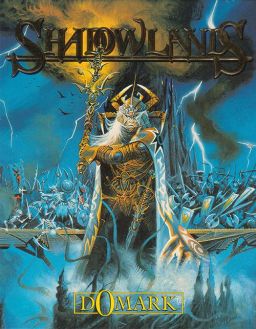
Shadowlands is a 1992 video game developed by Domark for DOS, Amiga, and Atari ST.
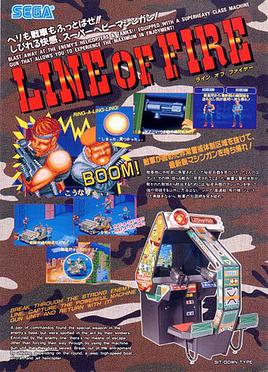
Line of Fire is a first-person light gun shooter game developed by Sega and released for arcades in 1989. It was released with two arcade cabinet versions, a standard upright and a sit-down cockpit, both featuring two positional guns. The cockpit design allows the player(s) to sit down while playing the game, while having two-handed machine guns, controlled by a potentiometer-controlled gun alignment software system. The game follows a two-man commando unit as they try to escape from a terrorist facility after seizing a prototype weapon.
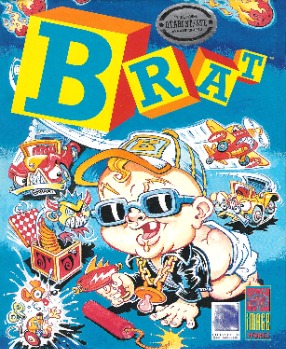
Brat is an action puzzle video game developed by Foursfield and published by Image Works for the Amiga and Atari ST in 1991.

Jurassic Park is a 1993 action video game developed and published by Ocean Software, for DOS and Amiga computers. The game is based on director Steven Spielberg's 1993 film, Jurassic Park, and also includes elements from author Michael Crichton's 1990 novel of the same name, which the film is based upon.

Rorke's Drift is a strategy video game for Atari ST, Amiga and MS-DOS home computers, released in 1990. The game is a recreation of the Battle of Rorke's Drift during the 1879 Anglo-Zulu War. The player assumes command of the British garrison at the Rorke's Drift shortly before the arrival of the 4,000-strong attacking Zulu force. The post's 137 defenders are rendered as individual characters which the player must order to perform actions. The game is played in real time and lasts from 4.30pm on 22 January 1879 until 7am the following morning. The game received mixed reviews, with critics praising the graphics and criticising the slow pace and complicated orders system.



















